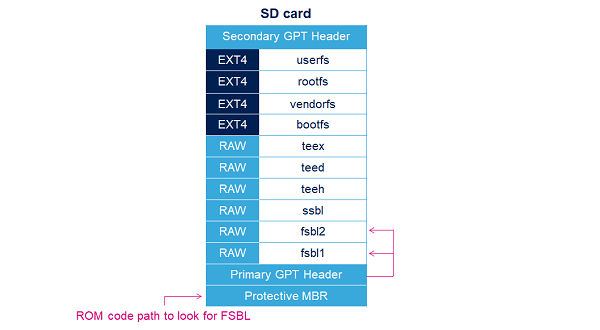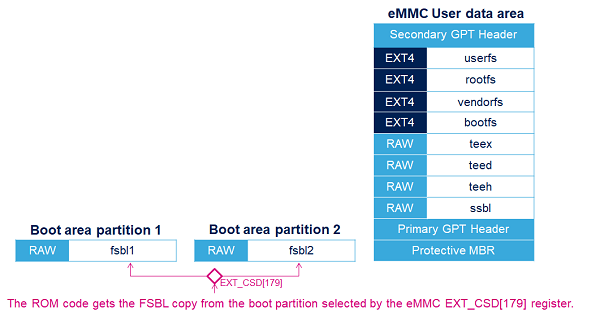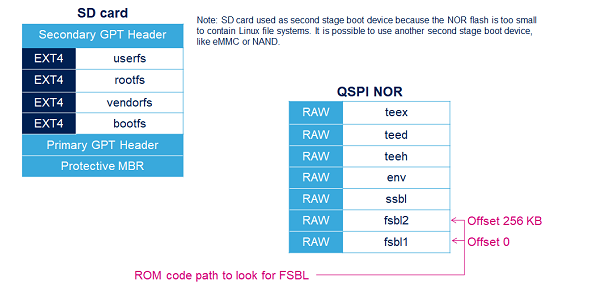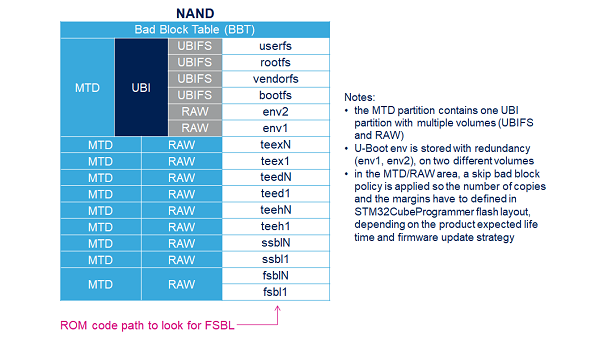1. Supported Flash memory technologies[edit source]
STM32MP15 boards support the following types of Flash memory:
- SD card on the SDMMC interface present on EVAL and DISCO boards
- e•MMC on the SDMMC interface present on EVAL board only
- Serial NOR Flash memory on the Dual QSPI interface present on EVAL board only
- NAND Flash memory on the FMC interface present on EVAL board only.
The next section lists all partitions used on STM32MP15 boards (size, name, and content), and the following sections show how they are mapped on the different types of Flash memory.
2. Flash partitions[edit source]
The tables below list the partitions defined for STMP32MP15 boards.
2.1. Minimal[edit source]
| Size | Component | Comment |
|---|---|---|
| Remaining area | userfs | The user file system contains user data and examples |
| 768 Mbytes | rootfs | Linux root file system contains all user space binaries (executable, libraries, and so on), and kernel modules |
| 16 Mbytes | vendorfs | This partition is preferred to the rootfs for third-party proprietary binaries, and ensures that they are not contaminated by any open source licence, such as GPL v3 |
| 64 Mbytes | bootfs | The boot file system contains:
|
| 2 Mbytes | ssbl | The second stage boot loader (SSBL) is U-Boot, with its device tree blob (dtb) appended at the end |
| 256 Kbytes to 512 Kbytes (*) | fsbl | The first stage boot loader is Arm Trusted Firmware (TF-A) or U-Boot Secondary Program Loader (SPL), with its device tree blob (dtb) appended at the end. At least two copies are embedded. Note: due to ROM code RAM needs, the FSBL payload is limited to 247 Kbytes. |
(*): The partition size depends on the Flash technology, to be aligned to the block erase size of the Flash memory present on the board: NOR (256 Kbytes) / NAND (512 Kbytes).
2.2. Optional[edit source]
| Size | Component | Comment |
|---|---|---|
| 256 Kbytes (*) | env | This partition is used to store the U-Boot environment while booting from NOR Flash. For all other Flash devices, the U-Boot environment is stored either in an EXT4 bootfs partition (e•MMC, SD card), or UBI volumes (NAND). |
| 256 Kbytes to 512 Kbytes (*) | teeh | OP-TEE header |
| 256 Kbytes to 512 Kbytes (*) | teed | OP-TEE pageable code and data |
| 256 Kbytes to 512 Kbytes (*) | teex | OP-TEE pager |
(*): The partition size depends on the Flash technology, as it should be aligned to the block erase size of the Flash device present on the board (256 Kbytes for NOR and 512 Kbytes for NAND).
3. SD card memory mapping[edit source]
The SD card has to be partitioned with GPT format in order to be recognized by the STM32MP15. The easiest way to achieve this is to use STM32CubeProgrammer.
The ROM code looks for the GPT entries whose name begins with "fsbl": fsbl1 and fsbl2 for example.
Note: The SD card can be unplugged from the board and inserted into a Linux host computer for direct partitioning with Linux utilities and access to the bootfs, rootfs and userfs partitions. The file system is Linux EXT4.

4. e•MMC memory mapping[edit source]
The e•MMC embeds four physical partitions:
- Boot area partition 1: one copy of the FSBL
- Boot area partition 2: one copy of the FSBL
- User data area: formatted with GPT partitioning and used to store all remaining partitions
- Replay Protected Memory Block (RPMB): not shown in the figure below, since not involved in the current boot chain.
STM32CubeProgrammer has to be used to prepare the e•MMC with the layout shown below, and to populate each partition.

5. NOR memory mapping[edit source]
As NOR Flash memory is expensive, its size is usually limited to the minimum needed to store only the bootloaders. The system files (bootfs, rootfs and userfs) are usually stored in another Flash memory, such as the SD card in OpenSTLinux distribution.
STM32CubeProgrammer must be used to prepare the NOR Flash and the SD card with the layout shown below, and to populate each partition.
It is possible to use an e•MMC card or NAND as second-level Flash memory, rather than an SD card. This requires the following aspects to be changed:
- The Flash memory layout, using STM32CubeProgrammer in order to write the rootfs and userfs to the targeted Flash memory
- The Linux kernel parameters, using U-Boot, in order to indicate where the rootfs and userfs have to be mounted.

6. NAND memory mapping[edit source]
STM32CubeProgrammer has to be used to prepare the NAND Flash memory with the layout shown below, and to populate each partition.
